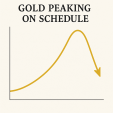U.S. Stocks Climb With Russell 2000 at Record; Gold Gains
New York (Dec 26) U.S. stocks rose, sending the Russell 2000 Index (SHCOMP) to an all-time high, and precious metals advanced. The ruble fell, trimming its biggest weekly jump since 1998, while Russian shares climbed for a third day.
The Standard & Poor’s 500 Index added 0.4 percent to a record at 10:14 a.m. in New York, and the Russell 2000 jumped 0.6 percent to top its March high. Gold advanced 1.8 percent and silver jumped the most since Dec. 9. Crude oil erased earlier gains to trade little changed. The ruble slipped 3.7 percent, while the Micex Index increased 1.3 percent. The Shanghai Composite Index posted its biggest two-day rally in five years amid speculation the government will step up stimulus. The yen headed for a second weekly decline.
Equity markets are rising this week, and U.S. stocks have regained their losses from earlier this month, with the Dow closing above 18,000 and the Nasdaq Composite Index poised for a 14-year high. The ruble is headed for its first weekly advance in a month amid speculation the government is ordering exporters to sell foreign currency. Most markets in Europe and Asia are shut today for Boxing Day, while the U.S. reopens after the Christmas holiday. Trading in S&P 500 stocks was 65 percent below the 30-day average at this time of day.
“That the U.S. recovery is on firmer ground amid a ‘patient’ Fed is buoying sentiment towards risk assets further,” Nicholas Spiro, managing director of Spiro Sovereign Strategy in London, wrote in an e-mail. “However, trading is thin and one shouldn’t read too much into this rally -- not least given the risk of a further slide in oil prices and the plethora of risks in emerging markets, in particular Russia.”
December Gains
U.S. stocks recovered losses from earlier this month as the Federal Reserve said it will be patient on the timing of interest-rate increases and the U.S. economy expanded at the fastest pace in more than a decade. Both the S&P 500 and the Dow are trading at records. The Dow has risen for seven days in its longest rally since March 2013.
The S&P 500 has advanced 1 percent this week, while the Dow is up 1.6 percent and the Russell 2000 has gained 1.5 percent.
The small-cap gauge has shown resilience this year, recovering from a correction that saw it slip 11 percent over a five-week period starting in early September. The index has surged 16 percent since reaching a one-year low on Oct. 13. Short interest in the iShares Russell 2000, an exchange-traded fund tracking the benchmark small company index, is the lowest in 17 months.
Even with its 4.3 percent gain in 2014, the Russell still trails the S&P 500, which has climbed 13 percent. The Dow has increased 9.1 percent year-to-date.
Russell Record
“Momentum has been building in the last month for small-cap names,” Michael James, a Los Angeles-based managing director of equity trading at Wedbush Securities Inc., said by phone on Dec. 24. ‘It’s merely playing catch up. Given that the Russell has lagged through this year, people are trying to find beta for performance.’’
It hasn’t been a smooth year for the index. The gauge lost 2.8 percent over a three-day period starting July 15 after the Federal Reserve expressed concern about valuations among social-media and biotech companies.
“Valuation metrics in some sectors do appear substantially stretched -- particularly those for smaller firms in the social-media and biotechnology industries,” the central bank wrote in assessing the U.S. stock market.
The Fed’s concern came after small-caps and Internet shares were the biggest victims of a market retreat early in the year as investors dumped the best performers of the bull market.
Gas Futures
Small-cap shares also fell faster than the broader market during an August selloff sparked by concern that a bear market in oil prices and slowing growth in China and Europe would hurt the U.S. economy.
The MSCI All-Country World Index rose 0.3 percent today and has climbed 0.8 percent this week.
West Texas Intermediate crude fell 0.3 percent after earlier rising. The gauge is heading for its 12th weekly decline in the past 13.
Natural gas futures fell below $3 per million British thermal units for the first time since 2012 on speculation that record production will overwhelm demand for the heating fuel.
Futures have slid 29 percent this year, heading for the first annual decline since 2011, as mild weather leaves stockpiles at a surplus to year-ago levels for the first time in two years.
Gold for immediate delivery climbed after prices dropped to near a three-week low on Dec. 24. Silver for spot delivery rose 3.2 percent and palladium increased 0.9 percent.
Dollar, Treasuries
The dollar strengthened 0.3 percent versus the euro, taking the U.S. currency up for a second week.
The rate on 10-year Treasuries slipped two basis points to 2.25 percent. The extra yield on the 30-year debt over five-year notes shrank to a six-year low in Asia after declining oil prices spurred speculation that inflation will slow, fueling demand for longer maturities.
The ruble earlier rose as much as 1.7 percent against the dollar. It’s advanced 7.3 percent this week as companies made year-end tax payments and the government ordered exporters including OAO Gazprom to sell foreign-exchange revenue.
“Exporters have to sell, and while volumes aren’t that large, it’s enough to move this thin market,” Iskander Abdullaev, analyst at Sberbank CIB, said in e-mailed comments. “I think there was an instruction to calm down the rate until the end of the year, so that retail clients don’t panic before holidays, and take off pressure from the ruble.”
Russia’s benchmark stock index is trimming a fifth weekly drop, its longest streak since June 2013.
Boost Lending
In China, the central bank plans to waive temporarily a requirement for lenders to set aside reserves for some deposits, people with knowledge of the matter said.
The Shanghai Composite Index advanced 2.8 percent today, bringing its two-day increase to 6.2 percent, the most since August 2009. The move by the People’s Bank of China highlights efforts to boost lending amid a slowdown in the world’s second-largest economy.
The yen weakened toward a seven-year low against the dollar after Japan’s consumer-price inflation slowed for a fourth month in November and industrial production shrank, adding to Prime Minister Shinzo Abe’s challenges in reviving the economy.
“The CPI results were almost in line with expectations but, excluding the tax hike, it looks quite weak,” said Yuji Saito, director of foreign exchange at Credit Agricole SA in Tokyo. “The market is starting to imagine there might be more easing, and that is leading to yen selling.”
Source: Bloomberg










